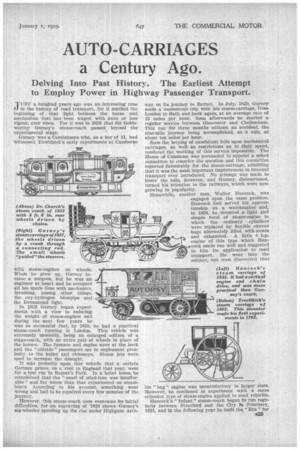AUTO-CARRIAGES a Century Ago.
Page 9

Page 10

If you've noticed an error in this article please click here to report it so we can fix it.
Delving Into Past History. The Earliest Attempt to Employ Power in Highway Passenger Transport.
ejUST a huadred years ago was an interesting time in the history of road transport, for it marked the beginning of that fight between the horse and mechanism that has been waged, with more or less vigour, ever since. For it was in 1828 that Sir Goldsworthy Gurney's steam-coach passed beyond the experimental stage.
Gurney was a Cornishman who, as a boy of 11, had witnessed Trevithick's early experiments at Camborae with steam-engines on wheels. When lie grew up, Gurney became a surgeon, but he was an engineer at heart and he occupied all his spare time with mechanics, inventing, among other things, the oxy-hydrogen blowpipe and the Drummond light.
In 1823 Gurney began experiments with a view to reducing the weight of steam-engines and during the next few years he was so successful that, by 1828, he had a practical steam-coach running in London. This vehicle was extremely unwieldy, being an enlarged edition of a stage-coach, with an extra pair of wheels in place of the horses. The furnace and engine were at the back and the " outside " passengers sat in unpleasant proximity to the boiler and chimneys. Steam jets were. used. to increase the draught. It was probably upon this vehicle that a certain German prince, on a visit to England that year, went for a test run in Regent's Park. In a letter home, he complained that the "smell Of oiled-iron was insufferable" and far worse than that experienced on steamboats. According to his account, something went wrong and had to be repaired every few minutes of the journey.
However, this steam-coach soon overcame its initial difficulties, for an engraving of -1828 shows Gurney's six-wheeler speeding up the rise under Flighgate Arch
way on its journey to Barnet. In July, 1829, Gurney made a momentous trip with his steam-carriage, from London to Bath and back again, at an average rate of 15 miles per hour. Soon afterwards he started a regular service between Gloucester and Cheltenham. This ran for three. months without an accident, the nine-mile journey being accomplished, as a rule, at about ten miles per hour.
Soon the levying of exorbitant tolls upon mechanical carriages, as well as restrictions as to their speed, rendered the working of this service impossible. The House af Commons was persuaded to appoint a select committee to consider the question and this committee reported favourably for the steam-carriage, admitting that it was the most important improvement in internal transport ever introduced. No attempt was made to lower the tolls, however, and Gurney, disheartened, turned his attention to the railways, which were now growing in popularity. Meanwhile, another man, Walter Hancock, was engaged upon the same problem. Hancock had served his apprenticeship as a .watchmaker and, In 1824, he invented a light and simple forni of steam-engine in which the ordinary cylinders were replaced by flexible canvas bags alternately filled with steam and exhausted. A little 4 h.p. engine of this type which Hancock made ran well and suggested to him its application to road transport, lie went into the subject, but soon discovered that his " bag " engine was unsatisfactory in larger sizes. However, lie continued to experiment with a more orthodox type of steam-engine applied to road vehicles.
Hancock's " Infant " steam-coach began to run regularly between Stratford and the City In February, 1831, and in the _following year he built the "Era" for
the London and Brighton Steam Carriage Co., one of the many companies that came into existence at about this time. Hancock also built the "Enterprise," which ran between the City and Paddington in 1833 and the "Autopsy," for service between Finsbury Square and Pentonville. Hancock seems to have paid greater attention to the travellers' comfort than Gurney did, his later models having lost their stage-coach appearance, being enclosed, with the passengers facing one another, as in the early buses, whilst the driver's compartment was situated at the back between the passengers' seats and the boiler and furnace. The steersman stood on a platform at the front of the vehicle.
In all, Hancock constructed ten steam-carriages, but the same restrictions that had caused Gurney to discontinue his experiments now led Hancock to follow suit. All the companies which had been formed to exploit road-coaches having failed, investors were turning their attention to the railways and Hancock reluctantly dropped the matter, although he kept a steam-carriage for his own use.
Lastly, the year 1828 saw one other attempt at a horseless-ca triage. This was nothing less than a carriage drawn by a kite. It was invented by a school master, who was so skilful in its guidance that, with a good wind and a clear road, he claimed to have travelled at 7,0 miles per hour! But even an ingenious and venturesome schoolmaster could not overcome the rather obvious drawbacks, however, and the vehicle did not come into general use.
















































